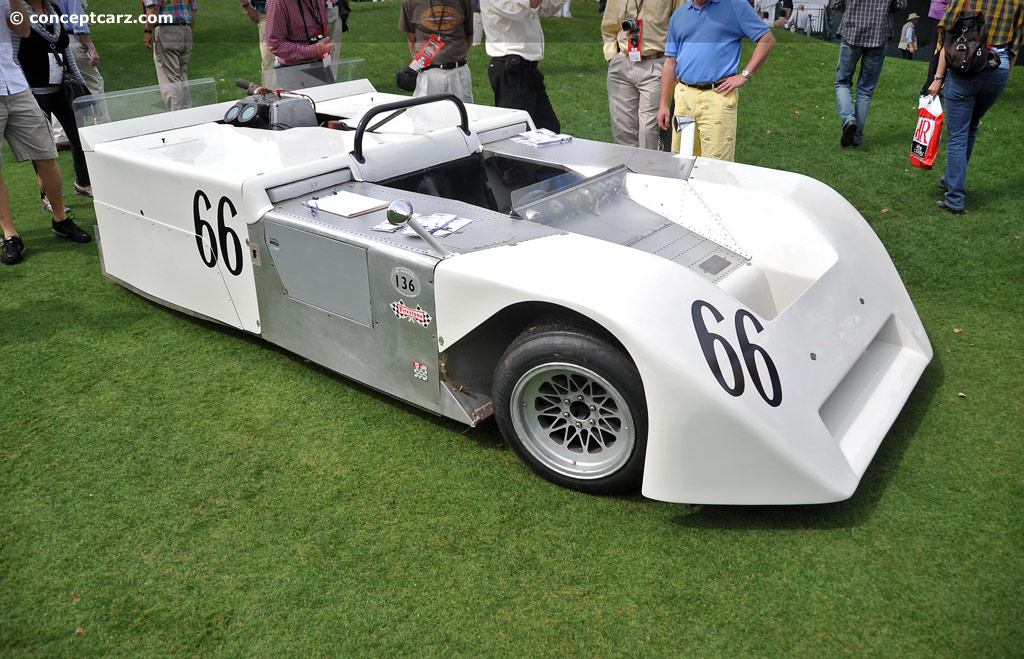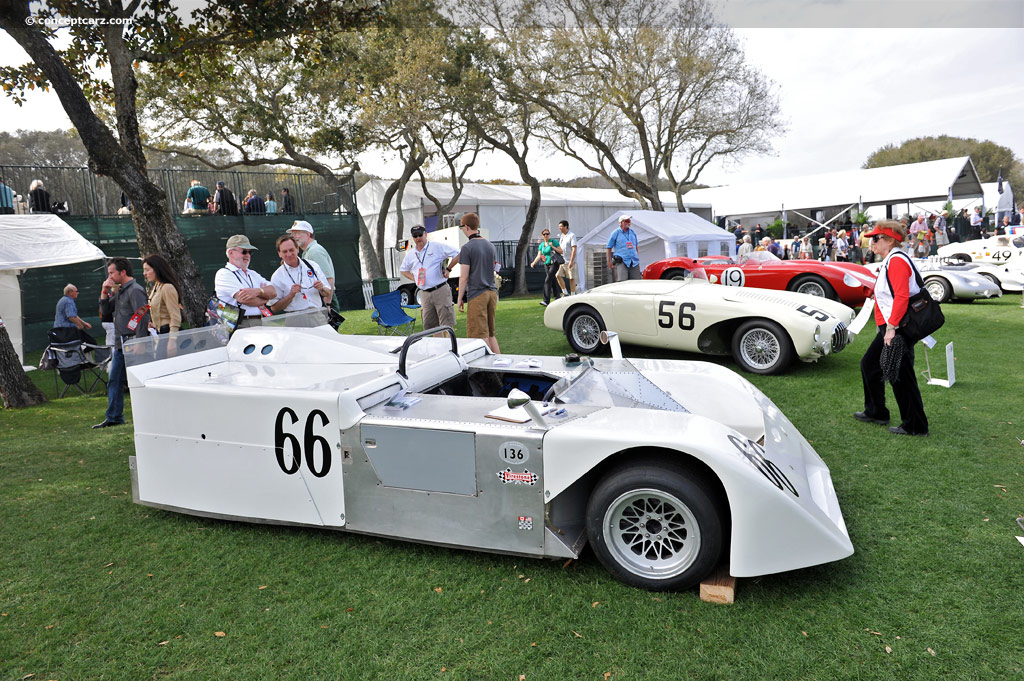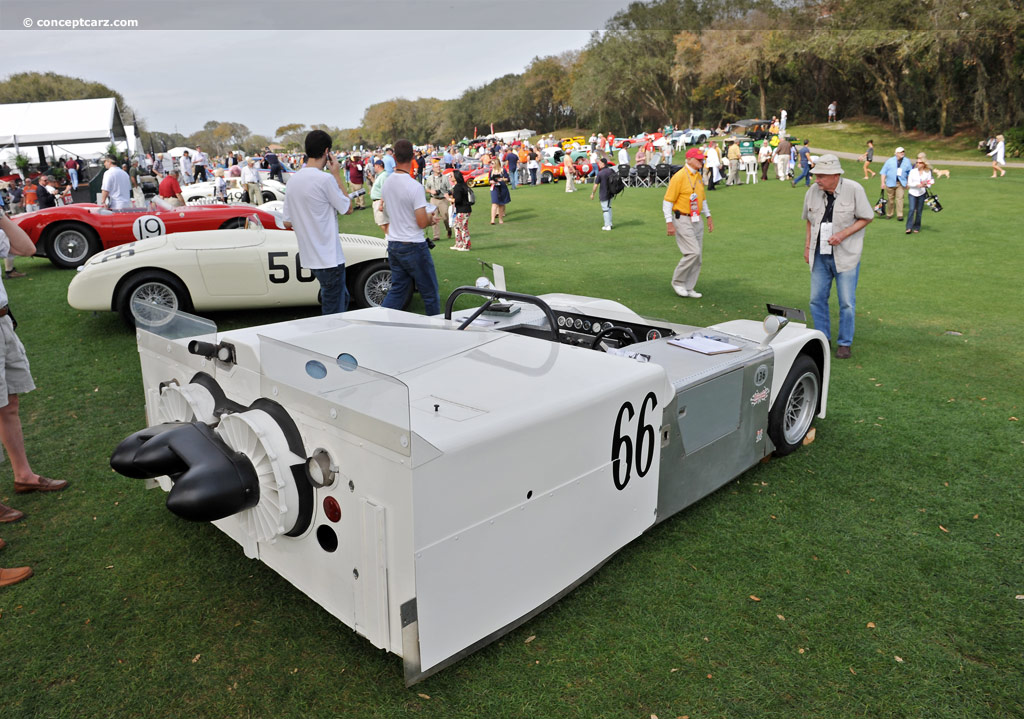Dick Troutman and Tom Barnes worked at Kurtis Kraft where they polished their metal-smith craft and fine-tuned their engineering expertise. They were responsible for the Troutman-Barnes Mercury Special of 1952, the Reventlow Scarabs of 1957 and 1958, and the first Chaparral of the early 1960s. They were pioneers of early American racing and helped push the classic front-engined sports racing roadsters to perhaps the height of their evolution.
Sport Roadster
Chassis #: 2J001
View info and historyTroutman and Barnes left the Reventlow operation in the fall of 1960 and went searching for a new source to back their venture. Their goal was to utilize a GM powerplant in a short-wheelbase vehicle where the engine would be mounted as far back as possible, in an effort to achieve near 50-50 weight distribution. The design was basically an improved Scarab that was lower, lighter, shorter, and weighed a few hundred pounds less. The racer was to have a fully independent rear suspension, all-wheel disc brakes and centralized fuel tanks. Barnes and Troutman called it their 'Riverside Sports Racer.' At Riverside in November, the partners found Texas oil businessman Jim Hall. Hall had competed in his first race in 1954 driving his brothers Austin Healey 100. This was the start of a passion that would continue to flourish throughout the years. Grateful for the financial assistance provided by Hall, Troutman and Barnes invited him to rename their Riverside Sports Racer. Hall selected 'Chaparral' after a Texas running bird. The new Chaparral made its racing debut at the 1961 SCCA race at Laguna Seca where it was piloted by Hall. The race track is one of the most successful breeding grounds for creativity, ingenuity, and new ideas. As cars continued to become faster and reach new speeds, new aerodynamic measures were needed to generate downforce, reduce drag, and keep the vehicle stable at high speeds. This was true for one of the world's most popular racing events - the Le Mans 24 Hours. 
Sport Roadster
Chassis #: 2J001
View info and historyJim Hall would become one of the more successful individuals in using aerodynamics to generate downforce. The early Chaparral was a front-engined sports racer that was later given a small metal strip on the nose, just below the air-intake. The result was one of the first (if not the first) 'spoiler' meant to generate downforce. The mid-engine Chaparrals that followed continued this pursuit of finding new ways of remaining stable at high speed. Hall experimented with wings, lips, and various other aerodynamic designs. One such example was the 2E, which had a high-mounted aerofoil. During braking and cornering, the aerofoil angled upward to help generate downforce. On the straight stretches, it would become horizontal to reduce drag as much as possible. In creating the mid-engine 2J, Hall used an aluminum monocoque and powered it with a big-block Chevrolet all-alloy engine. It was given a fuel-injection system, a displacement size over 7 liters, and developed 680 horsepower. The engine was mated to a Chaparral 3-speed automatic gearbox, which allowed the driver to push a pedal on the straights which would straighten-out the aerodynamic aerofoil. Girling ventilated disc brakes were placed at all four corners. The 2J, given the nickname, the 'sucker car,' was the ultimate example of lessons learned and experience with aerofoil, wings, and aerodynamics. The car employed a Rockwell snowmobile engine that sucked the air from underneath the car resulting in a low-pressure area. The result was a system that basically sucked the car to the ground. The two-cylinder Rockwell engine was mounted on top of the gearbox and the air was blown out the back by two large fans. The system worked; it generated downforce and did not have the negative effect of adding additional drag.
Sport Roadster
Chassis #: 2J001
View info and historyFormula 1 World Champion, Jackie Stewart, was hired to drive the 2J at its racing debut. The car, which had been rushed to completion, set the fastest lap but was not able to finish the race. The brake fluid had heated to the point it was boiling and the Rockwell engine failed. Teething problems were expected, considering the advanced technology and its lack of necessary testing and development. The car missed the next three races so it could be further developed. Upon its return, Vic Elford was in the driver's seat and drove it to the pole position. At the start of the race, the car was quickly overtaken by two Works McLarens with their manual gearboxes. After two laps, Elford was able to regain the lead. The fan-engine proved to be problematic for the 2J, but it managed to finish sixth overall.Up to this point, the sucker system had been the car's Achilles heel, but it was very clear that once all the bugs had been worked out of the system, the car would be unstoppable. Complaints were made to the sport's governing body by the other teams. Rather than adapt and create similar systems, the teams were successful in banning the car from competition. Elford was able to compete in the final race of the season, again earning the pole. But again, during the race the fan-engine broke, this time nearly causing an accident. The car was in the middle of a sharp, high-speed corner and the loss of suction nearly sent the car into the wall. At the end of the season, Hall turned his attention from sports car racing, to Indy Cars. The Chaparral 2K was driven by Johnny Rutherford to a victory in the 1980 Indy 500. 
Sport Roadster
Chassis #: 2J001
View info and historyHall put the Chaparral 2J into storage. In recent years, the car has been restored and been put on permanent display in the Petroleum Museum in Midland, Texas.
by Daniel Vaughan | Mar 2012

Sport Roadster
Chassis #: 2J001
View info and history

Sport Roadster
Chassis #: 2J001
View info and history

Sport Roadster
Chassis #: 2J001
View info and history

Sport Roadster
Chassis #: 2J001
View info and history
by Daniel Vaughan | Mar 2012
Can-Am VehiclesSimilarly Sized Vehicles
Similarly Sized Vehicles
from 1970
1970 Chaparral 2J Vehicle Profiles
Recent Vehicle Additions
Related Automotive News

Can-Am History Roars Back to Life at Spring Classic May 19-21
The Can-Am Series made its last appearance at Mazda Raceway Laguna Seca at the 1973 Monterey Grand Prix. Vic Elford (10) in the UOP Shadow was chased through the Corkscrew by winner Mark Donohue (6) in the dominant Sunoco Porsche 91730.
MONTEREY,...

MAZDA ROAD TO 24 SHOOTOUT JUDGES ANNOUNCED
Mazda Taps Motorsports Experts to Help Select %24100,000 Scholarship Winner
IRVINE, Calif. (November 10, 2016) – Mazda has confirmed the judges for the 11th annual Mazda Road to 24 Shootout. This post-season shootout will award a %24100,000...

CHEVROLET TO SHOW CHAPARRAL VISION GRAN TURISMO CONCEPT
Boundary-pushing, Chevy-powered race cars changed motorsports design
DETROIT – When racers Jim Hall and Hap Sharp founded Chaparral Cars in 1962, few could have guessed how they would shake up the conformities of the racing world – and...

Sports and Racing Rarities Lead Early Highlights For RM's Two-Day Arizona Sale
RM Auctions returns to the Arizona Biltmore Resort %26 Spa in Phoenix from January 16–17 to kick off its 2014 collector car season
Expanded to two days in 2014, the well-established sale will celebrate its 15th year by lifting the gavel on approxim...
RRDC VOTES IN 37 NEW MEMBERS FOR 2013
HILLIARD, Ohio (Nov. 7, 2013) - Thirty-seven race-car drivers and motorsports professionals have been voted into the Road Racing Drivers Club in 2013. The group includes 13 Regular Members from the open-wheel and sports-car racing ranks, 20 Associate...



























